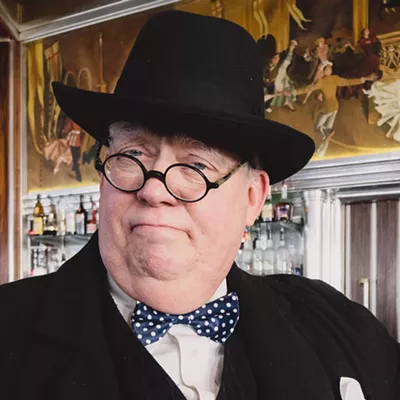Science Meets Religion ... Amicably?
The Rev. Michael Dowd talks on Evolution Theology6:30 p.m., Wednesday, Feb. 6
Unitarian Universalist Congregation Northwest
3601 W. Cromwell Drive
579-7094; thankgodforevolution.com
Two weeks ago, City Week recommended a lecture by Victor Stenger, who avows that modern science disproves the existence of God. In the interest of a multiplicity of perspectives, this week, I urge you to attend a lecture by the Rev. Michael Dowd, whose new book, Thank God for Evolution!, celebrates "the marriage of science and religion."
You may now be thinking, "Huh? I thought intelligent-design theorists were out for Darwinist blood."
But Dowd, a traveling spokesperson for evolution theology, stresses that while he isn't critical of the intelligent-design movement, he realizes it will never appeal to mainstream science.
"The term (design) implies a designer that knew it all ahead of time," Dowd says in interview. According to evolution theology, atoms, molecules, organisms and everything else in the universe are creative units that exist in a layered nesting system. Evolution is one such layer, God another. "God is the largest nesting doll," Dowd says, "a sacred name for ultimate reality and creativity."
In rebuttal to Stenger's claim that science disproves God, Dowd says, "Sure, the god he's talking about ... a trivial notion of God ... a supreme engineer. There's no evidence for this. But this is not the god I'm talking about."
Hard-core Darwinists and other scientists, including Stenger, may dispute the scientific methodology of Dowd's leap from atoms and molecules as creative building blocks to God as the pinnacle of creative design--but Dowd has stirred up some notable support.
"I hope this perspective ... is a bridge between deeply religious people and mainstream science," Dowd says.
But are secular scientists and the faithful even seeking such a bridge? Come and decide for yourself. The event is free, but donations are accepted. --Andrew Mortazavi
Lines and Layers
"K(nots) of Desire" by Lucinda YoungOpening Reception
6 to 9 p.m., Saturday, Feb. 2
Exhibit on display through Saturday, Feb. 23
Conrad Wilde Gallery
210 N. Fourth Ave.
622-8997; conradwildegallery.com
Encaustic painting dates back to the second century, when Egyptians used the hot-wax technique to create portraits of Christian icons. Since then, the technique has transformed, and today, contemporary artists push the technique's boundaries to create more complex pieces.
Lucinda Young uses this technique to create layered artwork that evokes a history as deep as the technique itself. Her works, on display at Conrad Wilde Gallery, feature lines that meander and bend into one another, forming convoluted knots--hence the exhibition's title, K(nots) of Desire. At times, these lines grow faint under another layer of beeswax, and it all adds up to art that captures the length of time and its complexity.
Young's own story reflects the nuances and complications of a traveled path over time. In an artist's statement, she explains how she relates to the lengthy, intersecting lines that illustrate her own journey from East Asia to Arizona. Young now resides in Santa Fe, N.M.
Beyond one person's story, the upcoming exhibition offers viewers with the chance to apply their own experiences to the work, allowing them to probe those twisted knots for whatever meanings they may find.
The opening reception is a part of Central Tucson Gallery Association's Art Safari. The following day, the gallery and Young will host an encaustic class that includes discussions, demonstrations and critiques from 11 a.m. to 5 p.m.; the cost is $150.
The exhibition is on display through Feb. 23. Gallery hours are 11 a.m. to 6 p.m., Tuesday through Saturday. --Matthew Kielty
A Double Dose
49th Annual Tubac Festival of the Arts10 a.m. to 5 p.m., Wednesday, Feb. 6, through Sunday, Feb. 10
Tubac Village
Exit 34 on Interstate 19
398-2704; tubacaz.com
We all know that this cooler weather won't last for long--so that makes now the perfect time to get outdoors. And if you don't mind leaving your house, the 50-mile drive to Tubac Village shouldn't deter you from attending the 49th Annual Tubac Festival of the Arts. This year's festival features 170 jury-selected artists, craft-makers and musicians.
Organizers note that there's nothing pretentious or snobby about the event. "Serious paintings share the street with whimsical sculptures and New Age music," they say on their Web site. Such inclusiveness promises for an interesting and varied display that won't lock out artists working in more traditional mediums like weaving and jewelry-making.
Much like the actual festival--which organizers say is Arizona's longest-running arts festival--the town of Tubac has a storied history that adventurous festival-goers can explore once they get their fill of street vendors, folk dance, music, and varied Southwestern and global food selections. Though now best-known as a year-round artists' colony, Tubac was once the site of Arizona's first Spanish Colonial garrison. Horse-drawn trolleys will be available to shuttle people around the historic village.
Though the festival showcases artists from all over the country and world, it also benefits hundreds of artists working in Tubac by attracting international art lovers. "Year-round, we have the brick-and-mortar artist studios," says Kim Etherington, administrative assistant for the Tubac Chamber of Commerce, the festival's sponsor. "So this is kind of like a double-dose of art: art everywhere you look."
Admission is free. There is a $6 parking fee. --Andrew Mortazavi
A Look at Global Problems
"What a Way to Go: Life at the End of Empire" Screening6 to 9:30 p.m., Saturday, Feb. 2
Bookmans
1930 E. Grant Road
887-2502
Apocalyptic documentaries are in. Al Gore's An Inconvenient Truth paved the way for filmmakers to take a critical view of what humans contribute to the planet (while snatching up award after award). But where Gore's film slacked in presentation, others have found ways to use the medium to their benefit.
One of these filmmakers is Tim Bennett. Growing up in the Midwest during the '80s, Bennett got involved with environmental issues that were just coming to the forefront of American concerns. And what issue did he start with? Global warming, of course.
From here, Bennett went on to study an array of issues and came to the conclusion that everything in this world is interconnected. Environmental concerns can't be discussed without talking about population overshoot and consumption rates, which leads to consideration of peak oil--and the possibility of mass extinction.
Bennett's dark muse found its voice in his film What a Way to Go: Life at the End of an Empire. The film combines nostalgic cartoons and home videos with interviews and facts to create a personal and interesting viewing experience. Yet because of Bennett's beliefs about interconnectivity, a lot of the information can be a bit cumbersome to grasp.
That's why Natural Systems Solutions, a group devoted to solving crises through natural means, is presenting a screening of the film that is to be followed by a facilitated discussion. Organizers hope the discussion provides possible solutions, or "lifeboats," as Bennett says in the film, to these problems on a local scale.
A donation of $5 to $25 is suggested, but it is not required.
When the doors open at 5:45 p.m., be prepared to come and re-evaluate your life, because as event organizer Dave Ewoldt puts it, "We can't keep living the way that we are." --Matthew Kielty







